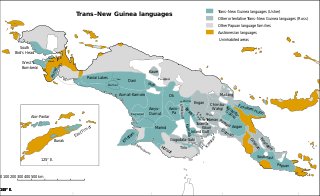Related Research Articles

Trans–New Guinea (TNG) is an extensive family of Papuan languages spoken on the island of New Guinea and neighboring islands, a region corresponding to the country Papua New Guinea as well as parts of Indonesia.

Southern Highlands is a province in Papua New Guinea. Its provincial capital is the town of Mendi. According to Papua New Guinea's national 2011 census, the total population of Southern Highlands is 515,511 spread across 15,089 square kilometers (5,826 sq mi).

Mount Hagen is the third largest city in Papua New Guinea, with a population of 46,250. It is the capital of the Western Highlands Province and is located in the large fertile Wahgi Valley in central mainland Papua New Guinea, at an elevation of 1,677 m (5,502 ft).
Enga is a language of the East New Guinea Highlands spoken by a quarter-million people in Enga Province, Papua New Guinea. It has the largest number of speakers of any native language in New Guinea, and is second over all after Papuan Malay.
The Piawi languages are a small family of Papuan languages spoken in the Schraeder Range of the Madang Highlands of Papua New Guinea that had been part of Stephen Wurm's Trans–New Guinea proposal. They are now connected to the Arafundi and Madang languages.
Sob is a Rai Coast language spoken in Madang Province, Papua New Guinea by approximately 2,500 people.
Daulo District is part of the Eastern Highlands Province in Papua New Guinea. It is along the Highlands highway leading to the other Highlands provinces, namely Simbu Province, Western Highlands, Southern Highlands and Enga Province. Daulo District shares geographical border with Simbu Province and Madang Province. Part of Daulo District's Upper Asaro Constituency is a walking distance to Mt. Wilhelm, Papua New Guinea's highest mountain in Simbu Province. Daulo is the real home of the famous Asaro Mudmen. It has a total population of over 45,000 people. It has a small district office administered by the District Administrator who is a representative of the provincial government. The electoral member for Daulo, with the help of the governor for the province, is responsible for the set up and running of Daulo District similarly with the other districts in the Eastern Highlands Province. The district was partly the implementation of the reform initiative undertaken by the Morauta government in 1995.
Awad Bing, or Biliau, is an Austronesian language spoken by about 1,100 people in seven villages near Astrolabe Bay, Madang Province, Papua New Guinea. Almost all speakers also use Tok Pisin as a second language. Awad Bing is also spoken by a few Ngaing for trading purposes.
For administrative purposes, Papua New Guinea (PNG) is divided into administrative divisions called regions and provinces. Papua New Guinea is divided into four regions and 22 province-level divisions: 20 provinces plus the autonomous region (Bougainville) and the National Capital District.
The Kowan languages are a small family of languages spoken in the Adelbert Range area of Madang Province, Papua New Guinea, and first identified by Malcolm Ross.
Anamgura (Anamuxra), or Ikundun, is a Papuan language of Madang Province, Papua New Guinea.
Maring, also known as Mareng or Yoadabe-Watoare, is a Trans–New Guinea language of the Chimbu–Wahgi branch. Speakers of the language can be found in the Bismarck range of the Madang province or in the Hagen district of the Western Highlands province. Dialects of the Maring language are Central Maring, Eastern Maring, Timbunki, Tsuwenki, Karamba, and Kambegl. All Maring speakers can understand the Central Maring dialect.
The Arafundi languages are a small family of clearly related languages in East Sepik Province, Papua New Guinea. They are conjectured to be related to the Piawi and Madang languages. They are named after the Arafundi River.
Biyom is a Rai Coast language spoken in Madang Province, Papua New Guinea. It has 650 speakers.
Musom is an Austronesian language spoken in the single village of Musom in Labuta Rural LLG, Morobe Province, Papua New Guinea. The other name for Musom is Misatik, given by the older generations because this was the name of the village that the ancestors settled on. Musom is currently an endangered language due to the fact that native Musom speakers are continuing to marry other language speakers. Musom is also endangered because of its change in grammar and vocabulary due to its bi- and multilingualism. In the Musom village, other languages that Musom speakers may speak are Aribwuang and Duwet. In the Gwabadik village, because of intermarriages other languages that Musom speakers may speak are Nabak and Mesem.
Enga Sign Language is an apparent village sign language among the Tato Enga people in Enga province, Papua New Guinea. It was reported in 1980 in three articles by Adam Kendon, based on ethnographic films of three signers in the upper valley of the Lagaip River, but with reports of wider use in the surrounding region. Its current status is unknown, as no more recent information is available.
Papua New Guinean Sign Language (PNGSL) is a sign language originating from Papua New Guinea. The standardised form of PNGSL was made an official language of Papua New Guinea in 2015.
Proto-Trans–New Guinea is the reconstructed proto-language ancestral to the Trans–New Guinea languages. Reconstructions have been proposed by Malcolm Ross and Andrew Pawley.
Events in the year 2020 in Papua New Guinea.
References
- ↑ Hagahai at Ethnologue (25th ed., 2022)

- ↑ Melliger & Melliger 2001.
Works cited
- Melliger, Markus; Melliger, Liisa (2001). Organised Phonology Data Pinai-Hagahai Language: Yenkis (Enga) – Enga & Madang Province. SIL.